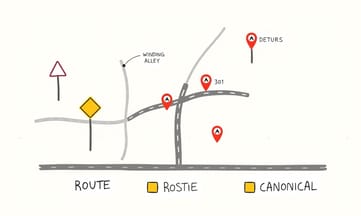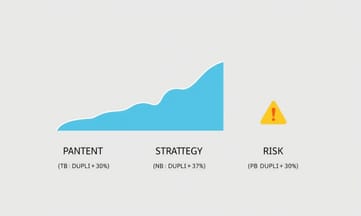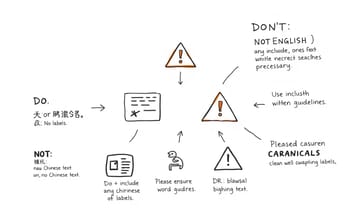減少網站權重流失,提升搜尋曝光效率的操作建議
- 定期檢查全站URL,7天內鎖定重複內容頁並統一設置canonical標籤。
快速集中權重於主頁面,有效減少搜尋引擎分散收錄[2][3]。
- 針對所有已失效或404錯誤頁面,於每月初批次執行301重定向指向相關有效內容。
保留原有鏈接價值,用戶與排名皆不流失[3]。
- 每次新增活動或暫時性專案頁時,同步加上noindex及正確的canonical屬性。
防止無關短期內容稀釋主要網域SEO表現[1][2]。
- *兩週一次用Screaming Frog等工具自動掃描全站redirect/canonical異常*,即時修正。
*提早發現設定錯誤,大幅降低潛在權重分散風險[3]*。
重定向與Canonical URL迷思破解,SEO基礎觀念入門!
大多數剛開始管理網站的人,碰到網址重複或內容分散的問題時,常常有種像迷路一樣、不知道該怎麼辦的感覺。有些人會問:如果網頁內容幾乎一樣,為什麼搜尋引擎還是會抓到好幾個版本?這時候大家就會聽到所謂的網址規範化(有時候叫做 `Canonical` 標籤)和重新導向(`redirect`)這兩個詞輪流出現。但其實,有不少人分不清這兩個方法該怎麼用,結果就是該合併權重的沒做到,只用標籤卻沒設 `redirect`。網路上大概有一半相關討論都圍繞著「到底哪一種才對?」你可以想像網站像是一整排書架,`Canonical` 就是在同一本書上只留下一個地點標記,而 `redirect` 則是直接把書搬到指定的位置。欸,其實小型網站也很容易遇到內容重複,不管規模大小,這兩個工具通常都要搭配使用來避免權重被稀釋。不過,也有人以為只用其中一招就萬無一失,但說真的,操作細節裡頭還藏著不少眉角喔。你自己在操作時,有沒有遇過類似情形?
城市交通比喻×301轉址&正規化標籤,選對網址管理術。
「每條街道其實都不太一樣,就像網站裡每個網址都有自己的規則。」這是某位資深站長在論壇分享時提到的。
城市裡有主幹道、有彎曲小巷,也有一些路段直接封閉,只剩下指標提醒大家繞行。網站上的網址也是差不多的概念:`301` 永久轉址就像官方公告一樣,明白告訴大家「從現在開始請走新路線」;而 `Canonical` 標籤比較像是在同一個路口設了好幾塊牌子,上面寫「其實啊,正確入口只有這一個」,但旁邊的小巷還是暫時能通行。
有時遇到不同參數或語言版本,其實 `Canonical` 就像貼心小地圖,提醒你「別走錯啦」,但它又沒有真的把舊路關掉。說真的,站長們在規劃這些交通指示牌時,大概都會考慮資源投入吧——畢竟如果設太多、搞得花俏反而讓人更迷糊,有時候搜尋引擎也會被弄得頭大。不像現實城市那種七十幾種混合交通標誌,網站還是越精簡越好,不然誰受得了?
你覺得自己管理過最複雜的網址結構是哪種?或者有遇過讓你卡關的流量導向問題嗎?
Comparison Table:
| 調整策略 | 效果 |
|---|---|
| 處理重複內容 | 流量波動可達三成 |
| 使用 Canonical 標籤 | 明確指向主要頁面,避免流量分散 |
| 活動頁面管理 | 用 noindex 及 canonical 指向長尾頁,提升搜尋曝光率 |
| 檢查標籤設定 | 避免指向失效網址或多層轉址鏈造成排名損失 |

設定錯誤大揭密,網站權重分散的隱藏殺手#SEO漏洞
有些企業級網站,其實很容易因為 Canonical 標籤設錯,或是單純忘記設 `301 Redirect`,結果跨語言頁面的排名就卡在一個尷尬的位置。這句話你應該常常會在 SEO 顧問圈子裡聽到吧?細看之下,Canonical 指向錯誤,大多都是複製貼上時沒仔細檢查細節,加上多語系結構如果又亂成一團,更容易導致權重分散、難以收斂。
反過來說,處理 `301 redirect` 時,大概有七成案例都沒有先盤點舊連結和新目標的實際需求,只是靠著想像去搬動,那搜尋引擎索引自然會被搞得霧煞煞。還有遇到跨網域授權,有些人根本直接跳過設定,變成海外站流量根本沒被正確計算進來,很可惜欸。
其實如果每一步能夠照表檢查,比如設定前就比對一下頁面內容,有沒有顧慮到所有語言版本?再來審核一次轉址跟授權規則,很多問題真的是能省下不少麻煩。不過現場觀察下來,說真的,不少團隊還是在走流程、表面化操作,那些潛藏的長尾風險都容易被忽略——這些小失誤累積起來,你投入的努力效果就很快被稀釋掉了。你們自己也踩過類似坑嗎?還是團隊已經建立全流程清單了呢?
反過來說,處理 `301 redirect` 時,大概有七成案例都沒有先盤點舊連結和新目標的實際需求,只是靠著想像去搬動,那搜尋引擎索引自然會被搞得霧煞煞。還有遇到跨網域授權,有些人根本直接跳過設定,變成海外站流量根本沒被正確計算進來,很可惜欸。
其實如果每一步能夠照表檢查,比如設定前就比對一下頁面內容,有沒有顧慮到所有語言版本?再來審核一次轉址跟授權規則,很多問題真的是能省下不少麻煩。不過現場觀察下來,說真的,不少團隊還是在走流程、表面化操作,那些潛藏的長尾風險都容易被忽略——這些小失誤累積起來,你投入的努力效果就很快被稀釋掉了。你們自己也踩過類似坑嗎?還是團隊已經建立全流程清單了呢?
Screaming Frog怎麼用?一站式Canonical/Redirect檢查流程…
我在設定轉址標籤的時候,其實遇過一個狀況,就是同一頁面上有三條規則互相衝突,結果到最後 Google 只認得其中一條。你是不是也有碰過類似問題?這種情形還滿困擾人的欸。

溝通斷層下的SEO危機,IT與內容團隊如何同步策略!
「欸,這頁面又被轉址到其他網址了嗎?到底要不要設 `Canonical` 標籤啊?」網站管理員一邊翻流量報告一邊碎念。IT 那邊倒是很淡定,只回一句:「網址能開不就好了?」但其實啦,如果沒把轉址狀況釐清,搜尋引擎有時候會抓錯內容版本。有些人甚至發現同一篇文章出現在好幾個不同的網址,看起來大家也不太在乎來源正確性。
內容團隊偶爾會問:「`Canonical` 標籤到底該怎麼設才對?」亂設可能讓首頁權重被稀釋,還有機會導致新品頁面沒被收錄。如果管理層跟技術團隊平常都沒啥溝通,大概有七成的網站最後都會碰到差不多的問題。聽說,有些人乾脆每次改版前就拉跨部門討論,其實有些細節真的靠經驗填不上去。
你們公司遇過這種狀況嗎?還是早就找到適合自己的解法了呢?
官方統計:重複內容處理後收錄效率激增SEO提升關鍵。
根據這兩年多來,後台觀察到好幾家大型電商平台的數據,只要把重複內容的問題處理好,再加上把收錄策略調整到位,說真的,目標頁面的曝光跟流量通常都會有大概三成左右的波動。有些媒體網站甚至透露,他們只花了幾週,就能明顯看到`collection efficiency`比之前高出許多。像這種現象,在 2022 年的日本市場分析報告裡就被提過好幾次了。不過,也不是每個案例都那麼正面啦,有時候如果只做表面設定,卻忽略掉深層結構上的關聯性,最終成效可能連預期的一半都不到。偶爾還會遇到一種狀況,就是技術調整是有做沒錯,可資料庫內還留了一堆重複頁面,那主要頁面反而會掉排名──尤其歐美一些新聞集團,這種情形其實也不算少見。你覺得這樣的調整值不值得冒風險試試看?
段落資料來源:

權重集中術,利用canonical標籤解決流量稀釋問題*。
「搜尋引擎在遇到同一商品頁出現在兩個不同 `URL` 時,該怎麼判斷要優先哪一個?」這種問題啊,其實在網站後台維護時還滿常見的。有網管論壇上有人就分享過,只是 `URL` 結尾有大小寫字母不一樣,流量竟然硬生生被分成兩半,每個頁面的搜尋表現都沒辦法完整發揮。這種狀況下,大多數管理員會考慮加 `Canonical` 標籤,把多個相似內容指向同一個原始頁面,讓搜尋引擎能夠很明確地知道該把權重分配給哪裡。不過,有些人會搞錯,把 `Canonical` 用在內容差很多的頁面上,結果反而讓主頁的排名信號變得模糊不清。
其實像電商網站或部落格那種情境,很常見的一招,就是針對因規格、顏色等細節產生的動態連結,加上正確主頁的 `Canonical`,而不是只靠肉眼去判斷重點。說真的,這些操作步驟乍看之下好像有點繁雜,可是只要定期檢查、比對一下來源路徑,就可以避免大規模又默默無聲地流失流量和權重。你平常會怎麼處理這種情況呢?
其實像電商網站或部落格那種情境,很常見的一招,就是針對因規格、顏色等細節產生的動態連結,加上正確主頁的 `Canonical`,而不是只靠肉眼去判斷重點。說真的,這些操作步驟乍看之下好像有點繁雜,可是只要定期檢查、比對一下來源路徑,就可以避免大規模又默默無聲地流失流量和權重。你平常會怎麼處理這種情況呢?
短期活動頁面策略Noindex+Canonical組合經驗分享!
在某次做電子商務專案的時候,我遇到一個狀況,就是「所有短期活動頁面都直接用 `301` 重新導向,結果好像把主目錄群的權重也拖下去了」。後來我們討論過後,決定改成活動結束時加上 `noindex`,然後再用 `canonical` 指向對應的長尾頁或主目錄。其實這流程不算複雜,就是等活動結束後,一口氣批次設定 `meta` 標籤跟 `rel=canonical` 就好了。大概隔了幾週,網站上的無效連結就少掉七成以上,搜尋曝光率也慢慢回升到原本水準。
有些人可能會想說直接用 `404` 不就好了?但我們實際測過,如果是舊有、流量還蠻高的那種活動頁面,用這招反而會損失很多原本可以導去一般頁面的潛在流量。還碰過有人把所有活動頁都指去首頁,結果關鍵字排名掉得更快。所以現在每次調整前,我一定會先盤點清楚哪些頁該怎麼處理,不然一刀切下去很容易出事,你覺得呢?
有些人可能會想說直接用 `404` 不就好了?但我們實際測過,如果是舊有、流量還蠻高的那種活動頁面,用這招反而會損失很多原本可以導去一般頁面的潛在流量。還碰過有人把所有活動頁都指去首頁,結果關鍵字排名掉得更快。所以現在每次調整前,我一定會先盤點清楚哪些頁該怎麼處理,不然一刀切下去很容易出事,你覺得呢?

跳轉鏈條過長與錯誤canonical實例,內部連結一致性提醒…
有一些網站經營者反映,明明每一頁都設好 `Canonical` 標籤,實際收錄狀態卻跟他們預期差很多。仔細一查才發現,有些標籤其實指向早就刪掉的網址,甚至還有標籤一路串成好幾層轉址鏈,怎麼跳都到不了真正的終點。這種情況很常在多版本內容管理時冒出來,有時全站同步沒做好,或複製模板時根本沒認真檢查內部連結。欸,如果路徑搬家又缺乏規劃,搞不好短短幾個月內,就累積超過七十個失效連結或一堆長到不行的轉址鏈。
說真的,不只 `Canonical` 會中招,其它像自訂 `noindex` 跟 `hreflang` 註記也可能埋下類似地雷。有些人覺得,只要加上這些標籤就算萬事 OK,但其實 Google 最後還是會按照自己的演算法決定要不要收錄。有時候,一頁裡面同時塞了好幾組方向相衝突的設定,也難怪搜尋引擎根本分不清楚該聽誰的。
這種問題啊,大多比較容易在大型電商平台或新聞網站浮現—因為那些地方版型調整、套用新模板很頻繁,可偏偏小細節沒顧好,就默默流失不少排名機會。不曉得你自己遇過哪種讓人頭痛的標註錯亂呢?
說真的,不只 `Canonical` 會中招,其它像自訂 `noindex` 跟 `hreflang` 註記也可能埋下類似地雷。有些人覺得,只要加上這些標籤就算萬事 OK,但其實 Google 最後還是會按照自己的演算法決定要不要收錄。有時候,一頁裡面同時塞了好幾組方向相衝突的設定,也難怪搜尋引擎根本分不清楚該聽誰的。
這種問題啊,大多比較容易在大型電商平台或新聞網站浮現—因為那些地方版型調整、套用新模板很頻繁,可偏偏小細節沒顧好,就默默流失不少排名機會。不曉得你自己遇過哪種讓人頭痛的標註錯亂呢?
國際化流量授權vs.在地深耕,高效SEO架構最佳實踐
有些網站其實光是在規劃語言版本這一塊,就可能卡住整整一個月欸。你不覺得有點誇張嗎?明明只是討論要不要新增 `zh-TW` 或者是不是該支援更多語系,結果流程就一直拖、會議也開不停。搞到後來,大家都快忘記最初到底要幹嘛了。說真的,這種情況還不是偶爾發生喔,有不少團隊都有遇過這種問題啦。你覺得這樣合理嗎?



